|
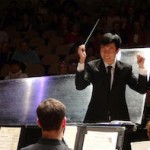

|
Please join the students in Climate Disruption, Conflict, and Peacemaking (PEAC 055 / ENVS 031) for an infographic session (similar to a poster session) on Monday morning December 11 at 10:30 a.m. in Shane Student Lounge.
Refreshments provided. This is a zero waste event.
With thanks for support from the Lang Center for Civic and Social Responsibility
The Department of Theater’s Directing I Workshop presents
Fall 2017 Night of Scenes
with excerpts from plays
by Annie Baker, Martin McDonagh
& Tennessee Williams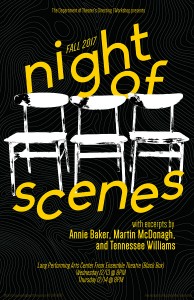
Directed by Max Markel, Rajiv Potluri,
& Arijit Nerukar
Lang Performing Arts Center
Frear Ensemble Theatre (Black Box)
Wednesday 12/13 @ 8PM
Thursday 12/14 @ 8PM
More info: lpacevents@swarthmore.edu or 610-328-8260
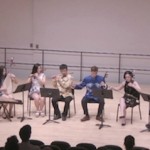
On Sunday, December 10 at 7:30 PM in Lang Concert Hall, the Chinese Music Ensemble will perform its debut concert as an official Swarthmore College ensemble. The group had previously been part of the Fetter Chamber Music program, performing only in the Fetter concerts each semester. Now, the group has sixteen members, with students performing on traditional Chinese instruments including the guzheng (zither), erhu (bowed fiddle), pipa (plucked lute), yangqin (hammered dulcimer), dizi (flute), and percussion.
Directed by Professor Lei Ouyang Bryant and Performance Associate Wang Guowei, the ensemble performs traditional and contemporary music from different regions of China and the Chinese Diaspora. Professor Bryant, who joined the Department of Music and Dance this fall, plays erhu in the ensemble, which she studied along with guzheng in Taiwan, China, and the U.S. Wang, an internationally touring erhu soloist and composer, has directed Chinese ensembles at Wesleyan University, Williams College, NYU, and the Westminster Choir College. He also arranged the versions of the folk songs that the ensemble will be performing in this concert. The program includes Cantonese folk song “Riding in the Countryside,” a medley of three folk songs, Ding Guoshun’s “Spring of Happiness,” Fan Shange and Geshanjida’s “Spring in the Snow-capped Mountains,” Taiwanese folk song “Catching Mud Carp,” Hunan folk song “Chestnut Flower,” and Jian Guangyi and Wang Zhiwei’s “New Song of the Herdsman.” The concert will feature soloists Annie Tingfang Wang, Henry Han ‘20, and Josephine Hung ‘19.
Desta Pulley
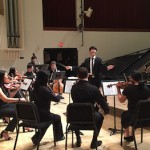
In response to increased student interest in conducting, Professor Andrew Hauze introduced the Lab Orchestra in the fall of 2016 as a way to give those students practice. This spring, they performed at the Pennsylvania Academy of Fine Arts (PAFA) thanks to Concert and Production Manager Jenny Honig’s efforts to find off-campus performance opportunities for the group. This semester, Swarthmore College Lab Orchestra co-conductors Andrew Kim ’18 and Shira Samuels-Shragg ’20 have had the experience of conducting not only the Lab Orchestra, but also the Jasper String Quartet, a Philadelphia-based group of professional musicians.
“Having a lab orchestra like this is very rare for an undergraduate program,” Kim says. “This is usually a model for graduate conducting programs. I don’t know of any other conducting opportunities even at bigger universities that undergrad students can get that parallels this kind of experience… it’s remarkable what we as a small department can do and the development that has happened in the past couple years thanks to Andrew and Jenny.”
According to Shragg, the rehearsals with the Lab Orchestra have allowed her to explore different interpretations of the pieces because she can ask the group to perform the piece in different ways. “You get the score, you go through it, and you try to figure out what everything means and what ideas you want to bring to it,” Shragg says. “The perfect situation is that you have such a strong image and understanding of how you want the piece to sound that you can simultaneously hear the orchestra, what they’re playing, and the idealized version you have in your head, and bring the orchestra to meet your vision for the piece. What’s fun with Lab Orchestra is because…it’s literally like a lab, we get to play around, whereas you could never walk into an L.A. [Philharmonic] rehearsal and say ‘oh, I’d like to try this passage three different ways.’ In this setting you can do that, we have done that.”
Kim says that conducting for professional musicians has facilitated the improvement of both the student conductors and musicians. “There’s more of a direct feedback with musicians have been playing in orchestras for a long time, so they can give pointed tips that work really well both for the players and us too,” he says. “I’ve just found that everything that they say clicks with both the musicians and me a lot.” Though the group gives feedback, Kim is still able to assert his own creative agency in the pieces that he conducts. “In my two semesters of working with them, I’ve found the space that I need to still be that leader,” he says. “Even though they’re much more accomplished musicians than I am, they’re good about still giving me that space and allowing me to do what I need to do.”
According to Shragg, the Jasper String Quartet prepares her for her career path as a conductor. “It’s different, but it’s great practice because anything that we get to conduct in the real world, that’s how it’s going to be,” Shragg says.
This weekend, Shragg and Kim will debut their holiday repertoire—featuring Sir Edward Elgar’s Introduction and Allegro, Covelli’s Christmas Concerto in G minor, Op. 5, No. 8, and “Winter” from Vivaldi’s Four Seasons—at the PAFA rotunda on December 3 at 2:00 P.M. and during the second half of the Fetter Chamber Music Concert on December 2 at 8 P.M. The Jasper String Quartet will be featured in the Elgar pieces as well as performing solos in the Covelli. Kim took the Jasper String Quartet’s suggestion of the Elgar pieces because of the beauty of the music as well as the late Romantic-era style. “I think it’s a challenging piece for our group but they’ve really kind of risen to the challenges of this piece,” Kim says.
Shragg, on the other hand, will conduct the Vivaldi and Corelli pieces. She was inspired to conduct Vivaldi’s “Winter” after hearing it played during her Music Theory class. Hauze suggested the Corelli as her first piece to conduct “because unlike the Elgar, it’s not super dense. It’s still beautiful and there’s a lot to explore there but it’s more manageable,” Shragg says. The Christmas Concerto was composed to follow the story of Jesus’s birth.
The common thread that ties the pieces that both Shragg and Kim have chosen for their fall repertoire is nature. The Elgar piece an English pastoral, the Corelli has a movement called “pastorale,” and the Vivaldi has its own corresponding poem that includes lines like “shivering, frozen mid the frosty snow in biting, stinging winds; running to and fro to stamp one’s icy feet, teeth chattering in the bitter chill.” Both hope that Swarthmore students who attend their performance will be inspired by the wonder of nature, without having to feel the “teeth-chattering,” “stinging” winter weather.
“[The element of nature] is something that’s close to Swarthmore students because we go to school in an arboretum,” Kim said “I hope that at a particularly busy time of the semester it can help people to take a break and even if they’re not outside in cold nature, they can experience nature kind of vicariously in our pieces.”
Bayliss Wagner ’21
This weekend, December 1-2, Pendle Hill, the Quaker retreat center on the other side of Crum Wood is holding a one-day (and one evening) workshop:
Right to Refuse: When Community Rights and Corporate Rights Conflict and What to Do Next
Featuring: Chad Nicholson, Malinda Harnish Clatterbuck, Dianne Herrin, and Paula Kline
https://pendlehill.org/events/right-refuse-community-rights-corporate-rights-conflict-next/
Whether it is a pipeline, a fracked gas well, or an incinerator, there are countless examples of corporations moving projects forward despite community resistance and environmental impact. Why? How has law evolved to protect corporate interests and what are a community’s options? What is a Home Rule campaign and why is it necessary? Explore these questions and more with a weekend with front-line organizers from across Pennsylvania. This is a workshop for those engaged in protecting their community from environmental threats for education and strategic planning.
On Sunday, December 3 at 11:45 AM in Whittier Room, George Alexander will speak on The Mariner East 2 pipeline: how it came to be, why it is so bad, and what we can do about it.
Perhaps you have heard about the Mariner East 2 pipeline, which is under construction in Delaware and Chester Counties. In full operation, this would be by far the most dangerous pipeline in the state of Pennsylvania. A rupture and explosion would destroy structures thousands of feet away and, depending on where it happened, could kill hundreds of people. How was this permitted to happen, and what can we do about it now? George Alexander will present background on the pipeline and outline what can be done. Rich and Claudia Aldred will speak about their experience as homeowners in the “blast zone” of the pipeline.
This year’s Fall Dance Concert will feature Taiko, modern, tap, and classical ballet, along with a work by Pitch (a dance co.), and pieces by student choreographers Marion Kudla and Sophie Gray-Gaillard. Performances will be held on December 8th at 4:30pm and December 9th at 8pm. Both shows are free and open to the public.
As part of the class on Pointe and Partnering that she teaches, Dance Professor Chandra Moss-Thorne often stages excerpts from classical ballets that require pointe work. Last year, for example, students performed the snow section from The Nutcracker. This year, Professor Moss-Thorne has staged the Jewels Divertissement from Sleeping Beauty, one of the most iconic divertissements in all of classical ballet. With music by Tchaikovsky and choreography by Marius Petipa, considered the most influential ballet choreographer in history, the short piece is a beautiful and efficient display of the most that classical ballet has to offer.
Pitch (a dance co.) will perform their piece, Request. Pitch is a “cross-disciplinary incubator” from the works of the accomplished dancers and choreographers Meredith Webster and Tania Isaac. The company combines modern and balletic techniques with “converging forms and ideas.” Request is a duet that the pair created in response to dance requests submitted to them by outside parties. With music by Arvo Part, the piece “is a collage of short dances that thread together the memory of people, relationships, fears, aspirations and moments in time.”
Marion Kudla ‘19 and Sophie Gray-Gaillard ‘20 will each present contemporary pieces that they have been working on since last spring. Both have trained extensively in classical and contemporary techniques and have been interested in choreography for a long time. Their pieces are part of their work for Dance Lab with Professor Kim Arrow. Kudla’s piece expands upon Thoreau’s idea that “the most alive is the wildest.” Her work, Imprints, “is inspired by places of wilderness, by places that remind us of what it is to be freed.” Gray-Gaillard’s work is a solo that focuses on the fluidity of the body’s movement through space, a style she admires in the work of Alonzo King and the Cambrians, among others. She based a large amount of her work in the convergences of improvisational and choreographed movement.
Each semester, the Dance Concert is a chance for students to share the hard work they have put into each of their classes, and for student choreographers to offer their first exciting takes on various dance forms. The concerts showcase the powerful dynamism of Taiko, the rapidly-evolving techniques of modern dance, and the rhythmic beauty of tap, along with new interpretations of classical and contemporary ballet. Swarthmore’s Dance Program gives voices to many different styles of dance, and the concerts are the realization of those voices.
Gabriel Hearn-Desautels ’20
21 courses are eligible for program credit, including 4 courses taught within the Peace and Conflict Studies program and 17 cross-listed courses.
Click here to download the list of eligible courses.
More information on Peace and Conflict Studies Courses:


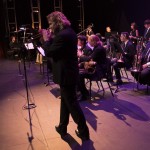
On Sunday, November 19th, the Swarthmore College Jazz Ensemble will perform in Lang Concert Hall. The concert begins at 7:30 and will feature the 21-piece student ensemble. They will perform a cross-section of music from the Great American Songbook, Latin jazz, big band standards and modern rock. Andrew Neu has been the conductor of the ensemble since 2014 and continues the long tradition of big band jazz at Swarthmore.
The program begins with the jazz standard “In a Mellow Tone,” composed by Duke Ellington. This arrangement was written by saxophonist Oliver Nelson and recorded by the Buddy Rich Big Band. It features freshman trumpeter, Owais Noorani-Kamtekar. The appropriately titled “Kids Are Pretty People,” by Thad Jones, was originally composed to be performed in the tiny jazz clubs of New York City. This performance features Sam Gardner on trombone. “What is This Thing Called Love” was composed by Cole Porter and arranged by conductor Andrew Neu. This up-tempo treatment features Vaughn Parts on alto saxophone and Josh Freier on tenor saxophone. Josh is again featured on the jazz ballad “Misty,” a tune made famous by Johnny Mathis. The first half wraps up with a very atypical piece for jazz ensemble. Originally recorded by the rock band Radiohead, “Bodysnatchers” has been adapted for big band by Fred Sturm. It was commissioned by the Lawrence University Jazz Ensemble and features Nathan Anderson on soprano saxophone, Sumi Onoe on piano, and Max Marckel on baritone saxophone.
The second half begins with “Cottontail,” another Duke Ellington piece, this one arranged by Duke himself. Olivia Gubler takes the lead on tenor sax. “Lament” is a haunting ballad composed by trombonist J.J. Johnson, and features Ben Hejna and the entire trombone section. Eric Chen plays a Debussy-inspired solo interlude on piano in the middle of the piece. Continuing with another intimate piece by Thad Jones, “Tip Toe” is based on the chord progression to “I Got Rhythm” in the less standard key of Ab. It features the saxophone section up front and a challenging trombone and bass soli featuring Derek Kinsella on the bass. Audiences will also hear solos from Owais, Josh, and Nathan, this time on alto saxophone.
The finale of the concert is an epic Latin jazz piece by trumpeter Arturo Sandoval called “A Mis Abuelos.” This tribute to his grandparents naturally features the trumpet section, along with Dakota Gibbs on guitar. Seth Stancroft drives it to the end with an open drum solo.
This year, the Department of Music and Dance is very excited to host jazz singer Janis Siegel at Swarthmore. She is a founding member of the musical group Manhattan Transfer and a multiple Grammy-award winner. On February 11, she will lead a workshop and perform a concert with pianist John DiMartino, bassist Gerald Veasley, and Andrew Neu on saxophone. She will join the Swarthmore College Jazz Ensemble for a special concert on April 7. This is a great opportunity to hear a world-renowned musician perform with the talented jazz students of Swarthmore College.
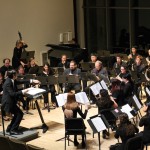
At 8:00 P.M. on Nov. 18 in Lang Concert Hall, the Swarthmore College Wind Ensemble, conducted by Professor Andrew Hauze, will bring its audience back to the early 20th century–back to the time of piano four-hands played in British and American homes, of ragtime in bars and brothels and dance halls, and of charismatic folk singers.
The hour-long concert will open with Lincolnshire Posy, an experimental fantasia by Australian composer Percy Grainger. Each of the six movements of the Lincolnshire Posy represents a different folk song that Grainger heard in his tour around the small villages of Lincolnshire. The folk songs memorialize historical events, including an unresolved feud between friends and the story of a missing sailor, once thought dead, returning home to his betrothed.
“In the music, it’s really interesting for the performer to see, ‘Okay, how’s Grainger taking this story and reimagining it in the way that he writes for the instruments?’” Hauze said. “Percy Grainger is not a household name, particularly in America, but he wrote some of the most original music you’ll hear. It has very traditional material so it’s very approachable—there’s a tune, you’ll get that—but at the same time it goes in these directions…when you listen to it and then you step back from it, it takes a moment to fully realize what you’ve heard.”
The second half of the concert will begin with dances composed by Antonín Dvořák. Dvořák’s mentor, Johannes Brahms, had written wildly successful Hungarian dances and suggested that Dvořák do the same. “These composers are mostly writing symphonies and very serious chamber music and in some cases opera, and these are kind of prestige things, but they’re not necessarily big moneymakers,” Hauze said. Some of Dvořák’s most popular and lucrative pieces were the Slavonic dances he then wrote, inspired by his home, the Czech lands. They were piano four-hands duets performed for family and friends as a favorite pastime of middle-class Europeans and Americans in the early 20th century.
In addition, the wind ensemble will perform “Danzon,” a Cuban-inspired piece from Leonard Bernstein’s score for a ballet called Fancy Free. “[“Danzon”] is also a little homage to Bernstein, because he’s entering his centennial year,” Hauze said. “He’s also one of my favorite composers, and wind ensemble in particular plays a lot of Bernstein. It’s really well suited to the group.”
The closing piece of the concert is “The Thriller,” a ragtime piano piece composed by May Aufderheide that Hauze arranged for wind and percussion instruments. According to Hauze, Aufderheide and her contemporary Julia Lee Niebergall were especially notable as a female composers from Indianapolis. “They weren’t in New York, they weren’t in one of the major metropolises, and they were women, and ragtime was dominated by male composers, both black and white,” Hauze said. “They wrote some great rags but they’re mostly kind of forgotten these days, and I really like to play them on the piano, so I thought it would be fun to start making some arrangements for wind ensemble.”
The link between the varied compositions chosen for the concert is that none were written as concert pieces; they were intended to be sung or danced along to. The lively and lighthearted rhythm of the concert may just make it hard to stay sitting down.
Bayliss Wagner ’21